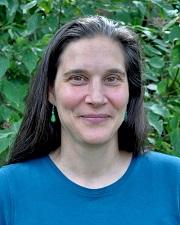Dr. Sharon Billings

- Professor, Senior Scientist
- University Distinguished Professor
- Research Interests: Ecosystem Ecology, Biogeochemistry, Forest and Grassland Responses to Climate and Land Use Change
Contact Info
Office Phone:
Department Phone:
Biography —
Dr. Sharon Billings' research characterizes the features governing nitrogen, carbon and water fluxes in terrestrial ecosystems, and how these dynamics are influenced by environmental change.
Research —
Our research investigates how forest and grassland biogeochemical cycling of carbon, nutrients, and water is influenced by climate, vegetation, nutrient availability, and natural and anthropogenic disturbance regimes. We explore scales ranging from microorganisms to the whole ecosystem. As such, we invoke tools from a wide range of disciplines, including ecosystem ecology, ecophysiology, microbial ecology and soil science. We quantify pools and fluxes of carbon and nutrients in soils and vegetation to assess how ecosystems respond to environmental conditions, often using stable isotopic signatures in biomass, soil organic matter, and multiple greenhouse gases to infer driving mechanisms.
Research interests:
- ecosystem ecology
- climate change
- soil organic matter
- microbial ecology
- biogeochemistry
- stable isotope ecology
Selected Publications —
- Richter, D. D., Billings, S. A., Groffman, P. M., Kelly, E. F., Lohse, K. A., McDowell, W. H., White, T. S., Anderson, S., Baldocchi, D. D., Banwart, S. Brantley, S., Braun, J. J., Brecheisen, Z. S., Cook, C. W., Hartnett, H. E., Hobbie, S. E., Gaillardet, J., Jobbagy, E., Jungkunst, H. F., Kazanski, C. E., Krishnaswamy, J., Markewitz, D., O’Neill, K., Riebe, C. S., Schroeder, P., Siebe, C., Silver, W. L., Thompson, A., Verhoef, A., and Zhang, G. 2018. Ideas and perspectives: Strengthening the biogeosciences in environmental research networks. Biogeosciences 15: 4815-4832. doi: 10.5194/bg-15-4815-2018.
- Philben, M., Butler, S., Billings, S.A., Benner, R., Edwards, K.A., Ziegler, S.E. 2018. Biochemical and structural controls on the decomposition dynamics of boreal upland forest moss tissues. Biogeosciences 15: 6731-6746. doi: 10.5194/bg-15-6731-2018.
- Ballantyne, F., Billings, S.A. 2018. Model formulation of microbial CO2 production and efficiency can significantly influence short and long term soil C projections. The ISME Journal. doi: 10.1038/s41396-018-0085-1.
- Ballantyne, F., Billings, S.A. 2018. Model formulation of microbial CO2 production and efficiency can significantly influence short and long term soil C projections. The ISME Journal. doi: 10.1038/s41396-018-0085-1.
- Billings, S.A., Hirmas, D., Sullivan, P.L., Lehmeier, C.A., Bagchi, S., Min, K., Brecheisen, Z., Hauser, E., Stair, R., Flournoy, R., Richter, D. deB. 2018. Loss of deep roots limits biogenic agents of soil development that are only partially restored by decades of forest regeneration. Elementa: Science of the Anthropocene 6: 34. doi: 10.1525/elementa.287.
- Philben, M., Billings, S.A., Edwards, K.A., Podrebarac, F.A., van Biesen, G., Ziegler, S.E. 2018. Amino acid δ15N indicates lack of N isotope fractionation during soil organic nitrogen decomposition. Biogeochemistry. doi: 10.1007/s10533-018-0429-y.
- Ziegler, S., Benner, R., Billings, S., Edwards, K., Philben, M., Zhu, X., and Laganiere, J. 2017. Climate warming can accelerate carbon fluxes without changing soil carbon stocks. Frontiers in Earth Science. doi: 10.3389/feart.2017.00002
- Billings, S., Min, K., Ballantyne, F., Chen, Y., and Sellers, M. 2016. Aging exo-enzymes can create temporally shifting, temperature-dependent resource landscapes for microbes. Biogeochemistry 131(1-2): 163-172.
- Billings, S., Glaser, S., Boone, A., and Stephen, F. 2016. Nonlinear tree growth dynamics predict resilience to disturbance. Ecosphere. doi:doi:10.1890/ES15-00176.1
- Lehmeier, C., Ballantyne, F., IV, Min, K., and Billings, S. 2016. Temperature-mediated changes in microbial carbon use efficiency and 13C discrimination. Biogeosciences 13: 3319-3329.
- Dialynas, Y., Bastola, S., Bras, R., Billings, S., Markewitz, D., and Richter, D. 2016. Topographic variability and the influence of soil erosion on the carbon cycle. Global Biogeochemical Cycles. doi:10.1002/2015GB005302.
- Billings, S., Boone, A., and Stephen, F. 2016. Tree-ring δ13C and δ18O, leaf δ13C and wood and leaf N status demonstrate tree growth strategies and predict susceptibility to disturbance. Tree Physiology, 36(5): 576-88.
- Min, K., Lehmeier, C. A., F. B., IV, and Billings, S. A. 2016. Carbon availability modifies temperature responses of heterotrophic microbial respiration, carbon uptake affinity, and stable carbon isotope discrimination. Frontiers in Microbiology 7: 2083.